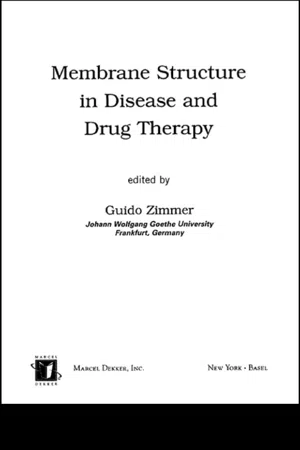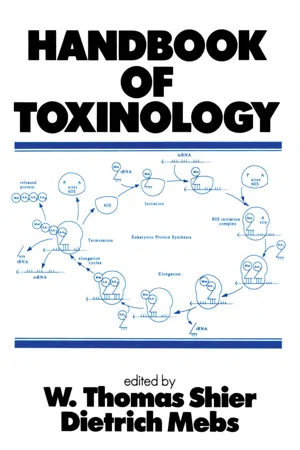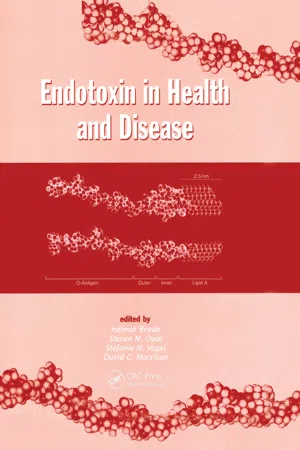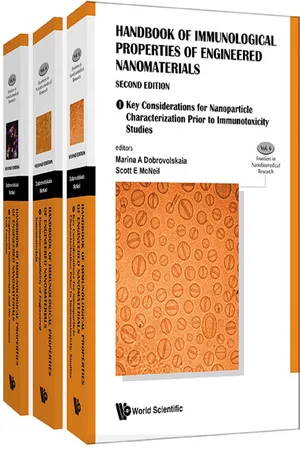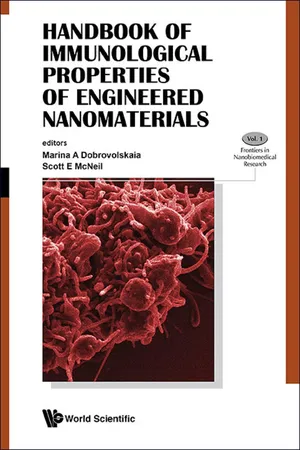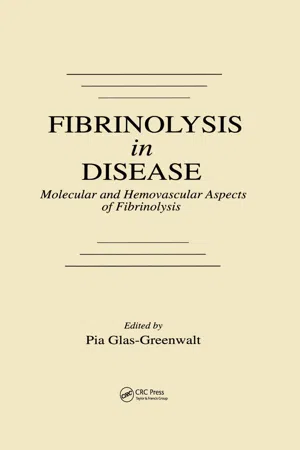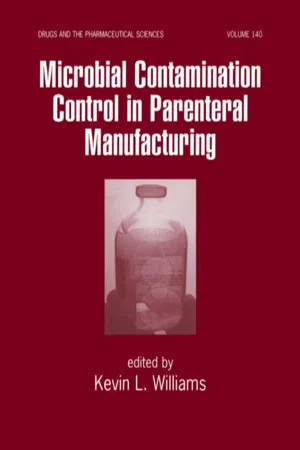Biological Sciences
Endotoxins
Endotoxins are toxic substances that are part of the outer membrane of certain types of bacteria. They are released when the bacteria die and their cell walls break down. Endotoxins can cause fever, inflammation, and other symptoms in humans and animals.
Written by Perlego with AI-assistance
Related key terms
9 Key excerpts on "Endotoxins"
- eBook - ePub
- Svante Cornell(Author)
- 2000(Publication Date)
- CRC Press(Publisher)
13 LipopolysaccharideA Membrane-Forming and Inflammation-Inducing Bacterial MacromoleculeUlrich Seydel, Artur J. Ulmer, Stefan Uhlig, and Ernst Theodor Rietschel Research Center Borstel, Borstel, GermanyI. INTRODUCTION
Endotoxins are formed by a certain group of bacteria, the gram-negative bacteria, which differ from other microorganisms by the unique architecture of their cell wall and thus their staining behavior as devised by Hans-Christian Gram (1 ). Endotoxins were originally described as heat-stable components of Vibrio chol-erae by Richard Pfeiffer (2 ) and are known today to be generally present in the cell envelope of gram-negative bacteria. Here they are major and integral components of the outer membrane, being exclusively located in its outer leaflet facing the bacterial environment. Endotoxins participate in the physiological membrane functions and are therefore essential for bacterial growth and viability (3 ). At the same time, Endotoxins represent a primary target for interaction with antibacterial drugs and components of the immune system of the host. They have therefore attracted the interest of microbiologists and bacterial geneticists, who initiated studies to understand the biosynthesis and the molecular basis of the vital function of Endotoxins for bacteria.Further, Endotoxins were recognized as potent toxins that, in higher organisms, elicit a broad spectrum of biological activities. They play an important role in the pathogenesis and manifestation of gram-negative infection in general and of septic shock in particular. As a result, Endotoxins intrigued clinical and biological researchers, who set out to elucidate their mode of action and to devise strategies aiming at control of the detrimental endotoxin effects observed during severe bacterial infection and sepsis. In addition, Endotoxins are capable of producing beneficial effects in higher organisms depending upon their amount and route of introduction (4 - eBook - ePub
- W. T. Shier, W. T. Shier(Authors)
- 2020(Publication Date)
- CRC Press(Publisher)
9 Bacterial Endotoxins JAROSLAV HOFMAN Institute of Microbiology, Czechoslovakian Academy of Science, Prague, Czechoslovakia- INTRODUCTION
- LOCALIZATION AND STRUCTURE
- Localization of Endotoxins in the cell membrane
- Isolation
- Chemical structure and assay
- Chemical structure of Endotoxins
- Synthetic lipid A
- Depyrogenation or detoxification of endotoxin
- Assay of Endotoxins: Limulus amebocyte lysate (LAL) test
- BIOLOGICAL ACTIVITIES
- Lethality
- Endotoxin-complement system interaction
- Interaction with the blood coagulation system
- Antibody response to endotoxin
- Stimulating and suppressive effect on the immune response
- Endotoxin effects on nonspecific resistance to infection
- Endotoxin and tumors
- Endotoxin-induced release of mediators
- CONCLUSION
- REFERENCES
I. Introduction
Endotoxin is a historical term for high-molecular substances from gram-negative bacteria. The name indicates that endotoxin is a constitutive part of a bacterial cell (“endo”) which, when applied to an organism, induces pathological changes (“toxin”). The term arose from observations that endotoxin is released from cells only with difficulty, either after breakdown or digestion of the cell. Together with relative thermostability, these properties distinguish endotoxin from thermolabile exotoxins, which, on the other hand, are spontaneously released by the microorganisms into the growth medium or during infection. Although the term “endotoxin,” which originated at the beginning of this century, has been replaced by other names expressing its partial properties, it is still used, and it denotes the most complex definition of the substance. An endotoxin is not only toxic, but it exhibits various other biological activities when administered to higher organisms or when added to humoral or cellular components in vitro. The spectrum of activities is unusually broad and unique among toxins. On the other hand, it is a substance present in very small but definite amounts in our body during our whole lifespan. It is not known what biological functions are affected by these low concentrations. - eBook - ePub
- Bradford P. Smith, David C Van Metre, Nicola Pusterla(Authors)
- 2019(Publication Date)
- Mosby(Publisher)
Endotoxemia and Sepsis
Kelsey A. Hart • Erin McConachie Beasley • Robert J. MacKay■ Definitions
The term endotoxin was originally coined to describe toxic bacterial components that were contained within or on the bacterial cell, in comparison with exotoxins that were secreted from outside bacterial cells. The heat-stable endotoxic activity of Vibrio cholera, identified by Richard F. J. Pfeiffer in the late nineteenth century, resides in lipopolysaccharide (LPS), the principal component of the outer leaflet of the outer membrane of all Gram-negative bacteria1 (Fig. 32.55 ). Today, the terms endotoxin (the activity) and LPS (the molecule) are used synonymously to refer to this specific Gram-negative bacterial membrane component, except when purified LPS is being referenced.2 Each LPS molecule has three structural domains: a polar polysaccharide O region, which projects into the aqueous extracellular environment; a hydrophobic lipid A region, which is largely buried in the bacterial outer membrane; and a core acidic oligosaccharide region connecting the other two. The O-region is highly variable, consisting of repeating units each of one to eight glycosyl residues, and contains antigens specific for each bacterial strain; the core glycolipid region is relatively constant among bacteria and mediates most of the toxic effects of endotoxin. On bacterial death or during bacterial proliferation, large (molecular mass > 106 D) aggregates of LPS and membrane protein are released. It is these protein-lipid micelles that constitute native endotoxin.FIG. 32.55Illustration of a cross-section of the double lipid bilayer that forms the cell membrane of Gram-negative bacteria. Lipopolysaccharide (LPS) is the principal component of the outer leaflet of the outer membrane. The insert - eBook - ePub
- Helmut Brade, Helmut Brade(Authors)
- 2020(Publication Date)
- CRC Press(Publisher)
11A Biophysical View on the Function and Activity of Endotoxins Ulrich Seydel, Andre Wiese, Andra B. Schromm, and Klaus BrandenburgResearch Center Borstel, Borstel, GermanyINTRODUCTION
Lipopolysaccharides (LPS) are known to constitute amphiphilic macromolecules located on the surface of gram-negative bacteria (1 ,2 ). They participate in the physiological membrane functions of the bacterial organism and are essential for its growth and survival (3 ). LPS are, at the same time, the primary target for interaction with antibacterial drugs and components of the immune system of the host.Released from the bacterial surface or in isolated form, LPS evoke an overwhelming spectrum of biological activities when administered to animals or humans or in vitro. They play an important role in the pathogenesis and manifestation of gram-negative infection in general and of septic shock in particular. Thus, lipopolysaccharides are also termed Endotoxins (4 ) and are among the most potent agents capable of inducing local or generalized inflammatory reactions in both humans and experimental animals.In gram-negative bacteria, the composition of the lipid matrix of the outer membrane is extremely asymmetric with respect to chemical structure and charge of the lipids. Thus, the outer leaflet is built up from LPS and the inner from a mixture of phospholipids (5 ). Chemically, LPS consist of a hydrophilic heteropolysaccharide, which is covalently linked to a hydrophobic lipid portion, termed lipid A, which anchors the molecule in the outer membrane. In wild-type strains, the polysaccharide portion consists of an O-specific chain and the core oligosaccharide (S-form LPS). Rough mutant strains do not express the O side chain but retain core oligosaccharides of varying length. The LPS of the various rough mutants are characterized by chemotypes in the sequence of decreasing length of the core sugar as Ra (complete core), Rb, Rc, Rd, and Re, the latter representing the minimal structure of LPS consisting only of lipid A and two 2-keto-3-deoxyoctonate (Kdo) monosaccharides. Lipid A is composed of a ±-glucosaminyl-(1 →6 )-α-D - eBook - ePub
Food Microbiology
Principles into Practice
- Osman Erkmen, T. Faruk Bozoglu(Authors)
- 2016(Publication Date)
- Wiley(Publisher)
Endotoxins are released from lysed bacterial cells as a result of effective host defense. However, structural components of cells can be released as soluble Endotoxins from the growing bacteria. Endotoxins are pyrogenic (fever producing) lipopolysaccharides released from the outer membrane of the lysed Gram-negative bacterial cell wall. Endotoxins are cell-associated substances that are structural components of bacteria. Most Endotoxins are located in the cell wall. Endotoxin refers specifically to the lipopolysaccharide or lipooligosaccharide (LOS) located in the outer membrane of Gram-negative bacteria. LPS consists of lipid A, polysaccharide, and core oligosaccharide. Oligosaccharide attaches directly to lipid A, and contains sugar and noncarbohydrate components (such as phosphate and amino acids). Polysaccharide is the O-antigen that can induce specific immunity. The term LOS is used to refer to a low molecular weight substance of bacterial LPS. LOS lacks O-antigens and has only lipid A and an oligosaccharide core. Endotoxins generally indicate bacterial growth. Bacterial Endotoxins, both soluble and cell associated, may be transported by blood and lymph and can cause cytotoxic effects on tissue. Some bacterial Endotoxins may also act at the site of colonization and play a role in invasion. Toxicity is not destroyed above 60 °C for hours. Endotoxins are weakly antigenic and not converted to toxoid. Endotoxins are synthesized directly by chromosomal genes.O-polysaccharide is responsible for the property of “smoothness” of bacterial cells, which may contribute to their resistance to phagocytosis. O-polysaccharide is hydrophilic and may allow diffusion of the toxic lipid in the hydrophilic environment. O-polysaccharide can act as a specific ligand (adhesion) for bacterial colonization that is essential for virulence characteristic. O-polysaccharide is antigenic, and the usual basis for antigenic variation in Gram-negative bacteria rests in differences in their O-polysaccharides.Physiological, pathological, and clinical effects of Endotoxins of different Gram-negative bacteria are similar. (i) The endotoxin causes liberation of interleukin-1. Interleukin-1 acts on thermoregulatory center and causes fever. (ii) Leukopenia occurs early with onset of fever. It may be followed by leukocytosis. (iii) Endotoxin enhances glycolysis in many cell types and can lead to hypoglycemia. (iv) Hypotension occurs early in Gram-negative bacteremia. (v) Endotoxic (septic) shock may develop in severe Gram-negative bacteremia. (v) Endotoxin activates complement system. (vi) Endotoxin causes coagulation of blood. (vii) Death may occur due to shock and bacteremia. (viii) Peptidoglycan of Gram-positive bacteria may produce similar activities as LPS of Gram-negative bacteria. However, peptidoglycan is much less potent toxic than LPS. - eBook - ePub
Handbook Of Immunological Properties Of Engineered Nanomaterials (Second Edition) (In 3 Volumes)
(In 3 Volumes)Volume 1: Key Considerations for Nanoparticle Characterization Prior to Immunotoxicity StudiesVolume 2: Haematocompatibility of Engineered NanomaterialsVolume 3: Engineered Nanomaterials and the Immune Cell Function
- Marina A Dobrovolskaia, Scott E McNeil(Authors)
- 2016(Publication Date)
- WSPC(Publisher)
Figure 1.Endotoxin contamination of nanoparticles may cause undesirable immunotoxicity. Endotoxin is a component of the Gram-negative bacterial cell wall. When endotoxin is introduced into a body (e.g., via injection into humans or animals), it may trigger immunostimulation and adverse reactions such as septic shock, tissue injury, and multiple organ failure. Endotoxin may be introduced into nanoparticle formulations during synthesis or handling.This chapter describes the current understanding of endotoxin biology as it pertains to the safety of medical products. We review common approaches to endotoxin detection and quantification in pharmaceutical formulations and medical devices. We also share some of the challenges in applying traditional methods of endotoxin detection to engineered nanomaterial formulations, discuss ways to minimize endotoxin contamination of engineered nanomaterials, and suggest methods and strategies for overcoming these challenges.2.What Endotoxin Is and Why It Is Important to Study in Nanoformulations
Endotoxin is a molecule of lipopolysaccharide (LPS), which is a part of the outer membrane of Gram-negative bacteria. The terms “endotoxin” and “lipopolysaccharide” are often used interchangeably, though endotoxin specifically refers to a crude (less pure) form of LPS containing other components of the bacterial cell wall.3 The composition of LPS varies among various bacterial strains; however, the principal structure is the same in all bacteria, consisting of: 1) a lipid A part, composed of a disaccharide backbone and negatively charged phosphates and fatty acids, and 2) a polysaccharide part (Figure 2 ). The lipid A part is the biologically active, toxic part of LPS, while the polysaccharide part is responsible for LPS antigenic properties. Depending on the length of the polysaccharide part, LPS can be classified as rough (contains the inner core only), semi-rough (contains the inner core and the outer core), or smooth (contains the inner core, outer core, and O-antigen). The biological activity of LPS in EU depends on the number of fatty acids and negatively charged phosphates on the lipid A part, and may vary from strain to strain.1 An estimation of biological activity can be obtained by converting the mass of LPS into EU using the relationship that 100 pg of endotoxin is approximately 1 EU of activity. An accurate way of determining the biological activity or potency of endotoxin, however, is by the analysis of individual endotoxin in a bioassay, such as the Limulus Amebocyte Lysate (LAL) assay discussed below.1 - Marina A Dobrovolskaia, Scott E McNeil(Authors)
- 2012(Publication Date)
- WSPC(Publisher)
Figure 1. Endotoxin contamination of nanoparticles may cause undesirable immunotoxicity. Endotoxin is a component of the Gram-negative bacterial cell wall. When endo-toxin is introduced into a body (e.g., via injection into humans or animals), it may trigger immu-nostimulation and adverse reactions such as septic shock, tissue injury, and multiple organ failure. Endotoxin may be introduced into nanoparticle formulations during synthesis or handling.are required to be tested for endotoxin contamination and conform to the upper limit of 5 EU per kilogram bodyweight per hour of injection (5 EU/ kg/h), except for intrathecally administrated drugs, for which the limit is 0.2 EU/kg/h.6 The allowable upper endotoxin limit for the surfaces of medical devices is 0.5 EU/mL, except for devices intended to come into contact with cerebrospinal fluid, for which the limit is 0.02 EU/mL.6This chapter describes the current understanding of endotoxin biology as it pertains to the safety of medical products. We review common approaches to endotoxin detection and quantification in pharmaceutical formulations and medical devices. We also share some of the challenges in applying traditional methods of endotoxin detection to engineered nanomaterial formulations, discuss ways to minimize endotoxin contamination of engineered nanomaterials, and suggest methods and strategies for overcoming these challenges.2. What Endotoxin Is and Why It Is Important to Study in Nanoformulations
Endotoxin is a molecule of lipopolysaccharide (LPS), which is a part of the outer membrane of Gram-negative bacteria. The terms “endotoxin” and “ lipopolysaccharide” are often used interchangeably, though endotoxin specifically refers to a crude (less pure) form of LPS containing other components of the bacterial cell wall.3- Pia Glas-Greenwalt(Author)
- 2019(Publication Date)
- CRC Press(Publisher)
responses. 15, 16 Humans or animals infected with Gram-positive organisms, fungi, or other microorganisms devoid of endotoxin develop a syndrome of cardiovascular failure and organ dysfunction similar to that observed in infections associated with endotoxemia. 8, 17, 18 Further, the infusion of endogenous mediators such as interleukin-1 (IL-1) or tumor necrosis factor (TNF) can initiate many inflammatory responses that are similar to sepsis. 19, 20 Thus, many of the inflammatory responses elicited by endotoxin are the same final common pathways that are activated by other mediators of inflammation. 21 Endotoxin should therefore be considered an important mediator in many cases of sepsis and septic shock due to Gram-negative organisms, but under other clinical circumstances it is not necessary nor central to the development of septic shock. Endotoxin Administration to Humans Bacterial components, including endotoxin, have been administered to humans during the past century for reasons as varied as therapy for malignancies or hypertension. 22, 23 In the research setting endotoxin has been given to characterize the pathogenesis of fever, stress hormones of the pituitary-adrenal axis, and leukocyte-bone marrow kinetics, as well as the pathogenesis of septic shock. 24 Limitations in this model are related to the toxicities associated with the endotoxin. infusion. To facilitate the standardization of bioassays and research with endotoxin, a reference endotoxin was developed by the Office of Biologies of the U.S. Food and Drug Administration, prepared from Escherichia coli (O 113:H 10:K negative). 25 Many contemporary studies of endotoxin administration to humans are based on the intravenous infusion of reference endotoxin at a dose of 2 to 4 ng/kg. Following the injection, normal subjects will develop an influenza-like illness that is characterized by chills or rigors 1 h after infusion- Kevin Williams(Author)
- 2004(Publication Date)
- CRC Press(Publisher)
181 (16), 4725−4733.4 . Raetz, C, et al. Gram negative endotoxin: an extraordinary lipid with profound effects on eukaryotic signal transduction. FASEB 1991, 5 (12), 2652–2660.5 . Galanos, C.; Luderitz, O. Lipopolysaccharide: properties of an amphipathic molecule. In Handbook of Endotoxin, Chemistry of Endotoxin; Rietschel, E.T., Ed.; Elsevier Science Publishers: NY, 1984; Vol. 1.6 . Rietschel; Brade. Bacterial Endotoxins. Sci. Am. 1992, (August), 54–61.7 . Amro, N.A., et al. High-resolution atomic force microscopy studies of the Escherichia coli outer membrane: structural basis for permeability. Langmuir 2000, 16 (6), 2789–2796.8 . Kelly, M.T.; Brenner, D.J.; J.J.F. III. Enterobacteriaceae. In Manual of Clinical Microbiology, Lennette, E.H., Ed.; American Society for Microbiology: Washington, D.C., 1985; 263–277.9 . Dundas, S.; Todd, W.T.A. Escherichia coli O157 and Human Disease. Curr. Opin. Infect. Dis. 1998, 11, 171–175.10 . Nnalue, A.N. All accessible epitopes in the Salmonella lipopolysaccharide core are associated with branch residues. Infect. Immun. 1999, 67 (2), 998–1003.11 . Rietschel, et al. Bacterial Endotoxins: molecular relationship of structure to activity and function. FASEB 1994, 8, 217–225.12 . Raetz, C. Biochemisty of Endotoxins. Ann. Rev. Biochem. 1990, 59, 129–170.13 . Nowotny, A. Relation of structure to function in bacterial endotoxin. Ann. Rev. Microbiol. 1977, 247–252.14 . Morrison, D.C., et al. Structure-function relationships of bacterial Endotoxins, contribution to microbial sepsis. In Infectious Disease Clinics of North America; Opal, S.M., Cross, A.S., Eds; Harcourt Brace & Co.: Philadelphia, 1999; 313–340.15 . Reitschel, et al. Chemical structure of lipid A. Microbiology, 1977, 262.16 . Sweadner, et al. Filtration removal of endotoxin (pyrogens) in solution in different states of aggregation. Appl. Envir. Micro. 1977, 34
Index pages curate the most relevant extracts from our library of academic textbooks. They’ve been created using an in-house natural language model (NLM), each adding context and meaning to key research topics.
